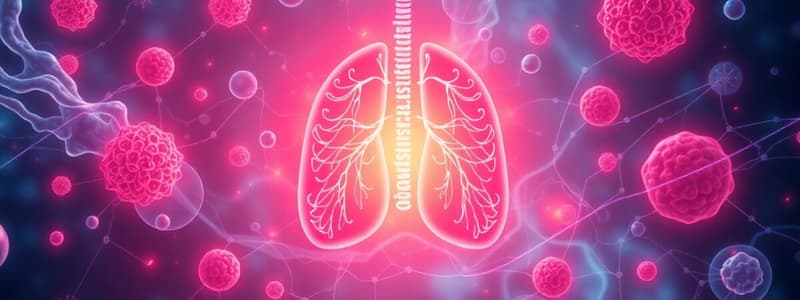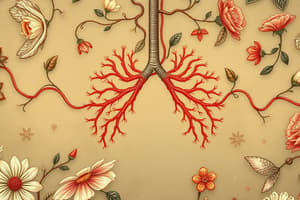Podcast
Questions and Answers
What is the primary purpose of glycolysis in aerobic respiration?
What is the primary purpose of glycolysis in aerobic respiration?
- To produce acetyl coenzyme A for the citric acid cycle.
- To generate a net gain of 2 ATP and 2 NADH molecules. (correct)
- To fully oxidize glucose into carbon dioxide and water.
- To initiate the electron transport chain.
Which statement correctly describes the preparatory phase of glycolysis?
Which statement correctly describes the preparatory phase of glycolysis?
- It requires input of ATP to phosphorylate glucose. (correct)
- It directly produces ATP and NADH.
- It results in the formation of pyruvate.
- It takes place in the mitochondria.
Where does glycolysis take place within the cell?
Where does glycolysis take place within the cell?
- In the cytoplasm. (correct)
- In the nucleus.
- In the endoplasmic reticulum.
- In the mitochondria.
Which of the following correctly represents the overall chemical reaction of aerobic respiration?
Which of the following correctly represents the overall chemical reaction of aerobic respiration?
What is the main by-product produced during the glycolysis process?
What is the main by-product produced during the glycolysis process?
What distinguishes a genotype from a phenotype?
What distinguishes a genotype from a phenotype?
Which mechanism of evolution involves the survival and reproduction of the fittest?
Which mechanism of evolution involves the survival and reproduction of the fittest?
What is a key characteristic of symbiotic relationships in ecosystems?
What is a key characteristic of symbiotic relationships in ecosystems?
Which best defines homeostasis in biological systems?
Which best defines homeostasis in biological systems?
In the context of evolution, what does speciation refer to?
In the context of evolution, what does speciation refer to?
How do genetic mutations contribute to evolutionary processes?
How do genetic mutations contribute to evolutionary processes?
Which of the following characteristics is NOT a feature of cell biology?
Which of the following characteristics is NOT a feature of cell biology?
Which statement correctly describes the role of hormones in physiology?
Which statement correctly describes the role of hormones in physiology?
Flashcards are hidden until you start studying
Study Notes
Aerobic Respiration
- A chemical process using oxygen to create energy from carbohydrates
- Also known as aerobic metabolism, cell respiration, and oxidative metabolism
- General Equation: Glucose + oxygen → carbon dioxide + water + energy
- Chemical Equation: C6H12O6 + 6O2 yields 6CO2 + 6H2O + energy (as ATP).
- Glucose is oxidized into carbon dioxide, and oxygen is reduced to produce water.
Stages of Aerobic Respiration
- Glycolysis: Breaks down glucose into pyruvate
- Transition reaction: Forms acetyl coenzyme A
- Citric acid (Krebs) cycle: Generates ATP, NADH, FADH2
- Electron transport chain and chemiosmosis: Generates the majority of ATP
Glycolysis
- Occurs in the cytoplasm
- Breaks down one glucose molecule (six-carbon sugar) into two pyruvate molecules (three-carbon sugar)
- Produces a net gain of 2 ATP and 2 NADH molecules.
Steps of Glycolysis - Preparatory Phase
- Phosphorylation: A phosphate from ATP is added to glucose, forming glucose-6-phosphate.
- Isomerization: Glucose-6-phosphate is rearranged to form fructose-6-phosphate.
Steps of Glycolysis - Pay-off Phase
- Further steps likely detail reactions and by-products
- Visual aids might be present to illustrate reactions and steps involved
- More information about the different steps and reactions are potentially in these illustrations
Genetics
- Heredity and Variation: Genetics studies how traits are passed down from parents to offspring and the variations that occur within populations.
- DNA Structure: DNA is a double helix made up of nucleotides. Each nucleotide consists of a sugar, a phosphate group, and one of four nitrogenous bases: adenine (A), thymine (T), cytosine (C), and guanine (G).
- Genes and Alleles: Genes are segments of DNA that contain the instructions for building proteins. Alleles are different versions of a gene.
- Genotype and Phenotype: Genotype refers to an organism's genetic makeup, while phenotype refers to its observable traits.
- Mendelian Genetics: Mendelian genetics explains the principles of inheritance, including:
- Dominance: One allele can mask the expression of another.
- Segregation: Allele pairs separate during gamete formation.
- Independent Assortment: Alleles for different traits assort independently.
- Genetic Mutations: Changes in DNA sequences can be beneficial, neutral, or harmful.
- Genetic Engineering: Genetic engineering uses techniques like CRISPR to modify organisms' DNA, offering potential for treating diseases and improving crops.
Evolution
- Change Over Time: Evolution describes the changes in the heritable characteristics of biological populations over generations.
- Natural Selection: Darwin proposed that organisms with traits that make them better suited to their environment are more likely to survive and reproduce, passing on those advantageous traits.
- Adaptation: Adaptations are traits that enhance survival and reproduction in a specific environment.
- Speciation: The formation of new and distinct species from existing ones through evolutionary processes.
- Fossil Record: Fossils provide evidence of past life forms and document the timeline of evolution.
- Common Descent: All living organisms share a common ancestor, suggesting a shared evolutionary history.
- Genetic Drift: Random fluctuations in allele frequencies within a population, particularly significant in smaller populations.
Ecology
- Organisms and Environments: Ecology studies the interactions between organisms and their environment, including both living and non-living components.
- Ecosystems: Ecosystems consist of communities of living organisms (biotic components) interacting with their physical environment (abiotic components).
- Trophic Levels: Trophic levels represent feeding relationships within an ecosystem:
- Producers: Autotrophs that produce their own food (plants).
- Primary Consumers: Herbivores that eat producers.
- Secondary Consumers: Carnivores that eat primary consumers.
- Decomposers: Organisms that break down dead organic matter.
- Biomes: Biomes are large geographic areas characterized by distinctive climate, vegetation, and animal life.
- Symbiotic Relationships: Interactions between different species that can be:
- Mutualism: Both species benefit.
- Commensalism: One species benefits, while the other is neither harmed nor helped.
- Parasitism: One species benefits at the expense of the other.
- Biodiversity: Refers to the variety of life forms within a habitat or ecosystem.
- Conservation: Conservation efforts focus on protecting endangered species and habitats, aiming to preserve biodiversity.
Physiology
- Maintaining Life: Physiology explores the functions and mechanisms that allow living organisms to maintain life.
- Homeostasis: Maintaining a stable internal environment, despite external changes. Examples include regulating body temperature, pH, and blood sugar levels.
- Organ Systems: Groups of organs that work together to perform specific functions, such as the circulatory system (blood circulation), respiratory system (gas exchange), and digestive system (food breakdown).
- Cellular Respiration: The process by which cells convert glucose and oxygen into energy (ATP) for cellular functions.
- Hormones: Chemical messengers that regulate a wide range of physiological processes, including growth, development, metabolism, and reproduction.
- Nervous System: A network of nerves that transmit signals rapidly throughout the body, coordinating responses to stimuli and controlling various bodily functions.
Cell Biology
- Building Blocks of Life: Cell biology focuses on the structure, function, and behavior of cells.
- Cell Theory: States that all living things are made of cells and that cells are the fundamental unit of life.
- Prokaryotic vs. Eukaryotic Cells: Prokaryotes lack a nucleus and other membrane-bound organelles, while eukaryotes have a nucleus and specialized organelles.
- Cell Membrane: A selectively permeable barrier that regulates the movement of substances in and out of the cell.
- Organelles: Specialized structures within eukaryotic cells that perform specific functions:
- Mitochondria: Powerhouse of the cell, where cellular respiration occurs.
- Endoplasmic Reticulum: A network of interconnected membranes involved in protein synthesis, lipid synthesis, and detoxification.
- Cell Division:
- Mitosis: Division of somatic cells, resulting in two identical daughter cells.
- Meiosis: Division of germ cells (cells that give rise to gametes), resulting in four genetically unique daughter cells.
- Apoptosis: Programmed cell death, a controlled process that eliminates damaged or unwanted cells, essential for development and maintaining homeostasis.
Studying That Suits You
Use AI to generate personalized quizzes and flashcards to suit your learning preferences.





